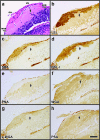Glycoconjugate expression in the olfactory bulb of the premetamorphic larva of the Japanese sword-tailed newt (Cynops ensicauda)
- PMID: 29540650
- PMCID: PMC5989032
- DOI: 10.1292/jvms.17-0679
Glycoconjugate expression in the olfactory bulb of the premetamorphic larva of the Japanese sword-tailed newt (Cynops ensicauda)
Abstract
We examined the organization of the olfactory organ and assessed the lectin histochemistry to investigate the glycoconjugate distribution of the olfactory bulb in premetamorphic larvae of Cynops ensicauda. The nasal cavity was an oval chamber that contained olfactory epithelium and a primitive vomeronasal organ. Secretory products were found in the supporting cells of the two sensory epithelia and in the respiratory cells. Ten lectins bound to the olfactory and vomeronasal nerve fibers as well as to the glomeruli in the olfactory bulb. The binding intensity in larvae was weaker than that reported previously in mature animals. This difference suggests a functional correlation between the expression change of glycoconjugates and the developmental refinement of the olfactory system during metamorphosis.
Keywords: lectin; metamorphosis; olfactory system; salamander; vomeronasal organ.
Figures


Similar articles
-
Heterogeneous expression of glycoconjugates in the primary olfactory centre of the Japanese sword-tailed newt (Cynops ensicauda).Anat Histol Embryol. 2018 Feb;47(1):28-37. doi: 10.1111/ahe.12320. Epub 2017 Oct 19. Anat Histol Embryol. 2018. PMID: 29052233
-
Lectin histochemical study on the olfactory bulb of the newt, Cynops pyrrhogaster.Anat Histol Embryol. 2011 Dec;40(6):419-25. doi: 10.1111/j.1439-0264.2011.01087.x. Epub 2011 May 19. Anat Histol Embryol. 2011. PMID: 21592192
-
Characterization of glycoconjugates and sialic acid modification in the olfactory bulb of the Chinese fire-bellied newt (Cynops orientalis).Anat Histol Embryol. 2020 Mar;49(2):260-269. doi: 10.1111/ahe.12524. Epub 2019 Dec 18. Anat Histol Embryol. 2020. PMID: 31854005
-
Segregated pathways in the vomeronasal system.Microsc Res Tech. 1998 Jun 15;41(6):519-29. doi: 10.1002/(SICI)1097-0029(19980615)41:6<519::AID-JEMT7>3.0.CO;2-H. Microsc Res Tech. 1998. PMID: 9712199 Review.
-
Glycobiology of the olfactory system.Acta Anat (Basel). 1998;161(1-4):234-53. doi: 10.1159/000046461. Acta Anat (Basel). 1998. PMID: 9780362 Review.
Cited by
-
Ecological Risks Due to Immunotoxicological Effects on Aquatic Organisms.Int J Mol Sci. 2021 Aug 2;22(15):8305. doi: 10.3390/ijms22158305. Int J Mol Sci. 2021. PMID: 34361068 Free PMC article. Review.
References
-
- Eisthen H. L., Polese G.2006. Evolution of vertebrate olfactory subsystems. pp. 355–406. In: Evolution of Nervous Systems, Vol. 2: Non-mammalian Vertebrates. (Kaas, J. ed.), Academic Press, Oxford.
-
- Franceschini V., Ciani F.1993. Lectin histochemistry of cell-surface glycoconjugates in the primary olfactory projections of the newt. Cell. Mol. Biol. 39: 651–658. - PubMed
MeSH terms
Substances
LinkOut - more resources
Full Text Sources
Other Literature Sources

